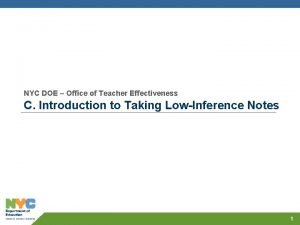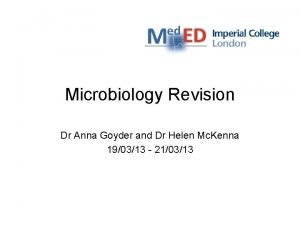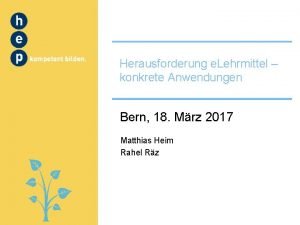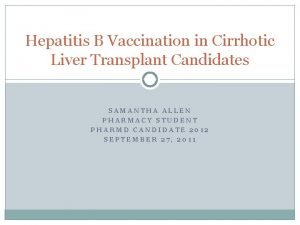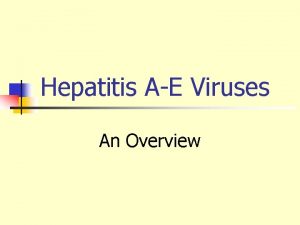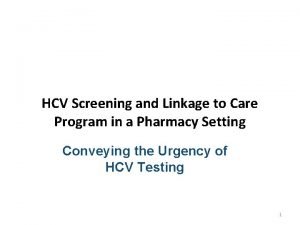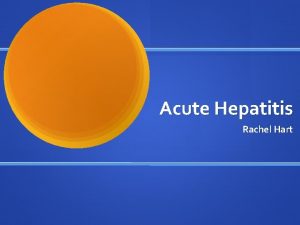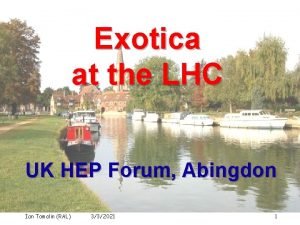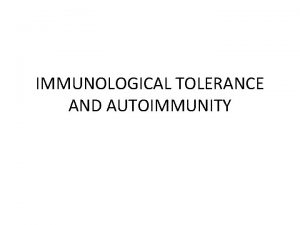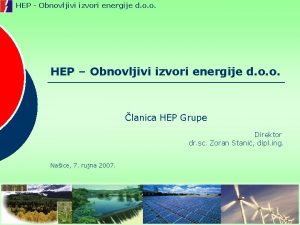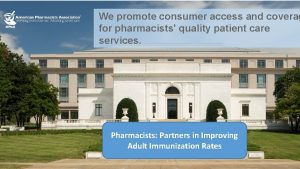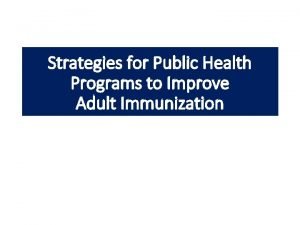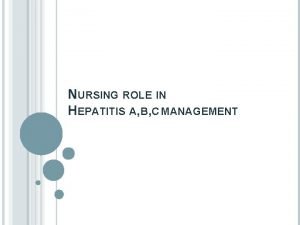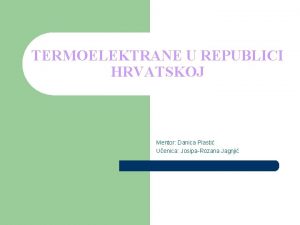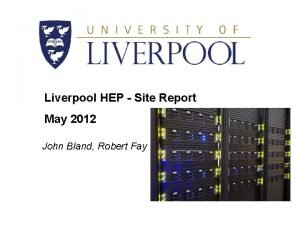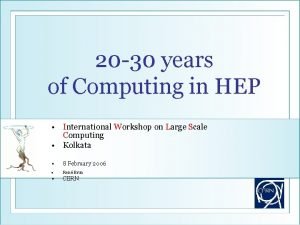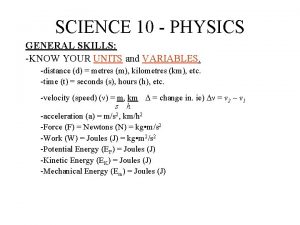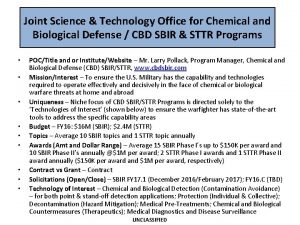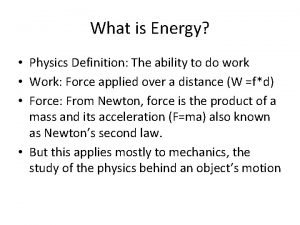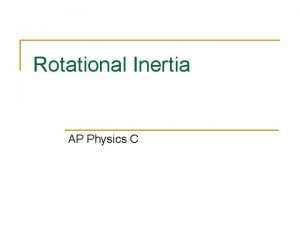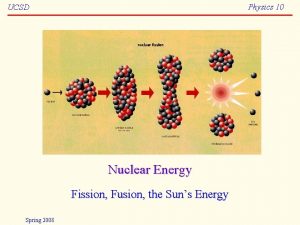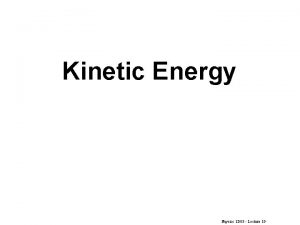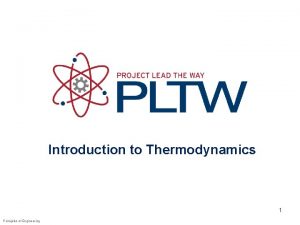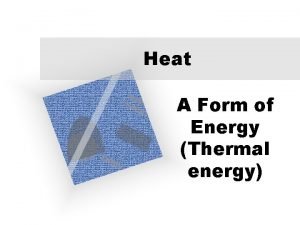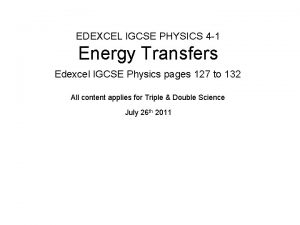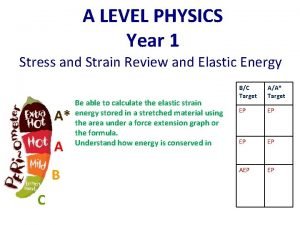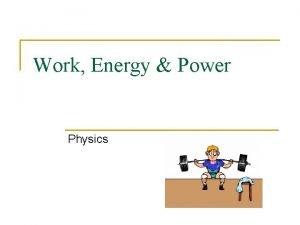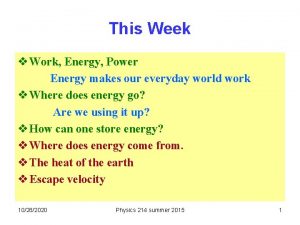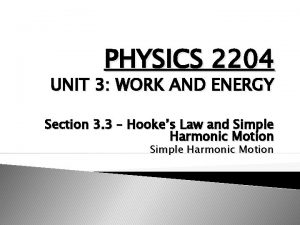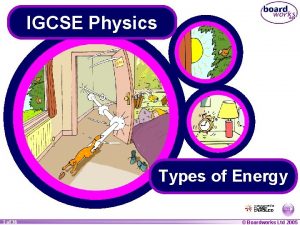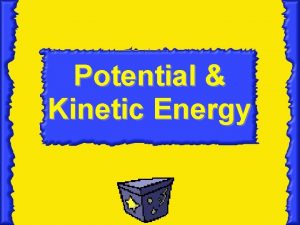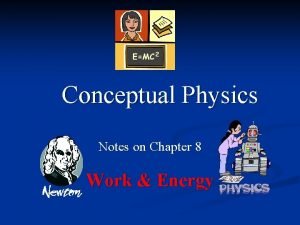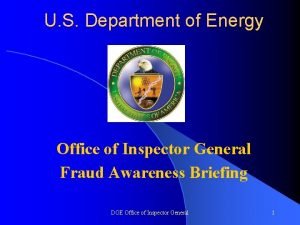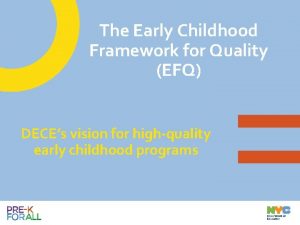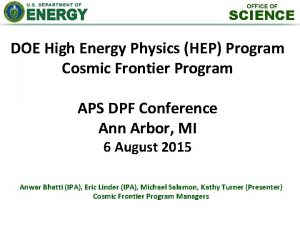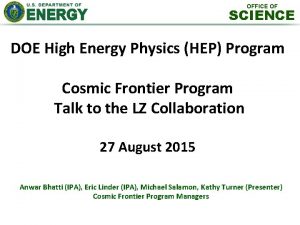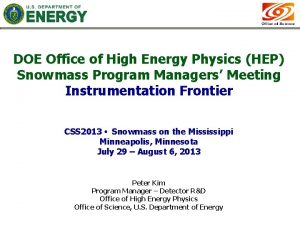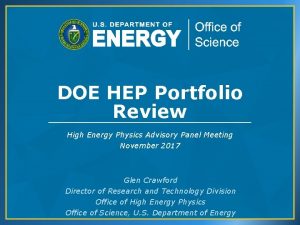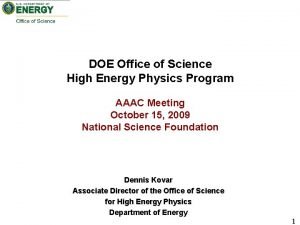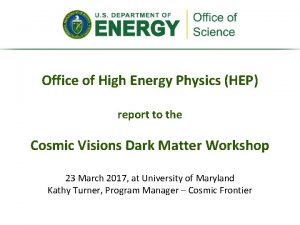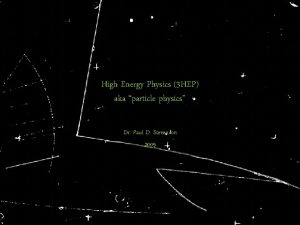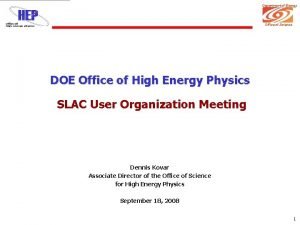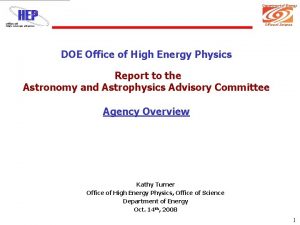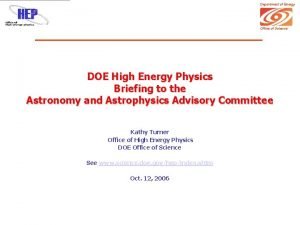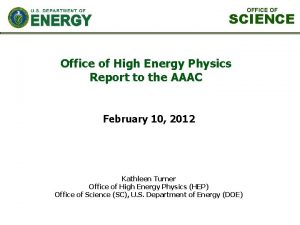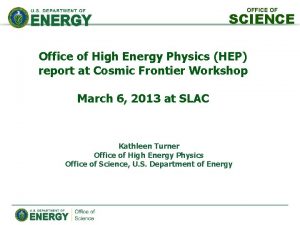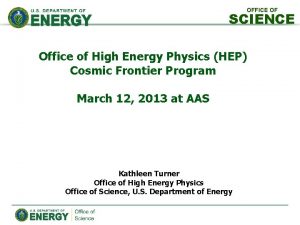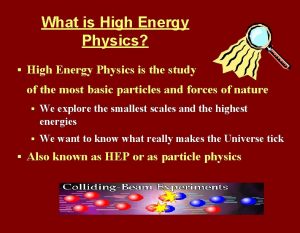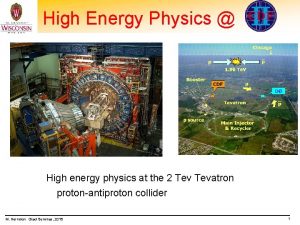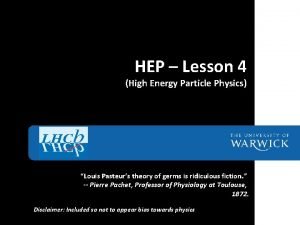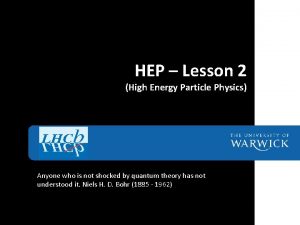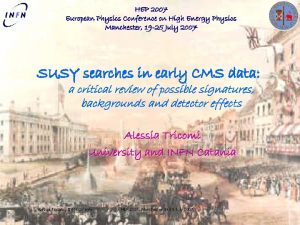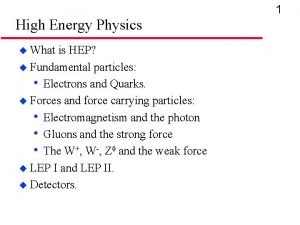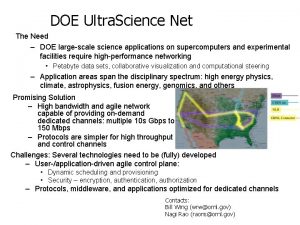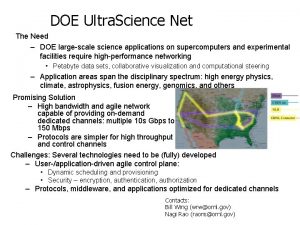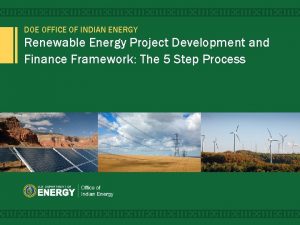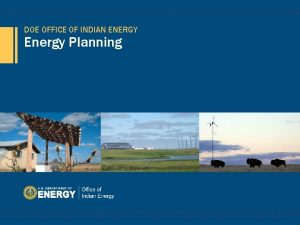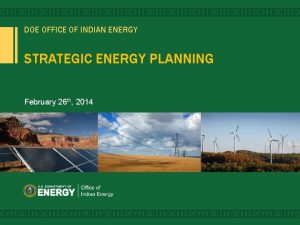OFFICE OF SCIENCE DOE High Energy Physics HEP



















































- Slides: 51

OFFICE OF SCIENCE DOE High Energy Physics (HEP) report to the CMB-S 4 Collaboration Meeting Dark Energy Camera (DECam) on the Blanco 27 February 2017 Kathy Turner, Cosmic Frontier Program Manager 1

Outline § HEP Mission & Program § Cosmic Frontier Program § CMB-S 4 CDT will support needs for HEP to go forward CMB-S 4 Collaboration Mtg at SLAC, 2/27/17 2

The High Energy Physics Program Mission …is to understand how the universe works at its most fundamental level: – Discover the elementary constituents of matter and energy – Probe the interactions between them – Explore the basic nature of space and time The Office of High Energy Physics fulfills its mission by: – Building projects that enable discovery science – Operating facilities that provide the capability to perform discovery science – Supporting a research program that produces discovery science CMB-S 4 Collaboration Mtg at SLAC, 2/27/17 3

HEP Research Subprograms • • • Energy Frontier researchers accelerate particles to the highestenergies ever made by humanity and collide them to produce and study the fundamental constituents of matter and the architecture of the universe Intensity Frontier researchers use a combination of intense particle beams and highly sensitive detectors to make extremely precise measurements of particle properties, study rare particle interactions, and search for new physics Cosmic Frontier researchers seek to reveal the nature of dark matter and dark energy by using particles from space to explore new phenomena Theoretical and Computational Physics provide the framework to explain experimental observations and gain a deeper understanding of nature Advanced Technology R&D fosters fundamental research into particle acceleration and detection techniques and instrumentation Accelerator Stewardship coordinates with accelerator user communities and industry to develop innovative solutions to critical problems, benefitting the broader user communities and the discovery science CMB-S 4 Collaboration Mtg at SLAC, 2/27/17 4

HEP Program Guidance FACA panels & subpanels provide official advice: • High Energy Physics Advisory Panel (HEPAP) – Jointly chartered by DOE and NSF to advise both agencies • Provides the primary advice for the program – Subpanels for detailed studies (e. g. Particle Astrophysics Science Assessment Group “PASAG” in 2009, Particle Physics Project Prioritization Panel (“P 5”) in 2008, 2014 • Astronomy and Astrophysics Advisory Committee (AAAC) – Advises DOE, NASA, and NSF on selected issues, overlaps, areas of mutual interest and concern – Subpanels: • These were joint AAAC & HEPAP: TFCR (2006), DETF (2006), DMSAG (2007) • AAAC Subpanel: CMB-S 4 CDT Formal Advice Also Provided by: • National Academy of Sciences (NAS) – Reports: New Worlds New Horizons (2010) Decadal Review of Astronomy & Astrophysics, “Middecade review” (2016) – Ongoing: Board on Physics & Astronomy (BPA), Committee on Astronomy & Astrophysics (CAA) – Future Planning starting w/ Agencies & Community: 2020 Astronomy/Astrophysics Decadal Survey Other: Community input (e. g. Snowmass, Small Project Dark Matter Workshop (March 2017) CMB-S 4 Collaboration Mtg at SLAC, 2/27/17 5

P 5 Strategic Plan The Science Drivers of Particle Physics The 2014 Particle Physics Project Prioritization Panel (P 5) report identified five intertwined science drivers, compelling lines of inquiry that show great promise for discovery: • Use the Higgs boson as a new tool for discovery *2013 • Pursue the physics associated with neutrino mass • Identify the new physics of dark matter *2015 • Understand cosmic acceleration: dark energy and *2011 inflation • Explore the unknown: new particles, interactions, and physical principles * Since 2011, three of the five science drivers have been lines of inquiry recognized with Nobel Prizes CMB-S 4 Collaboration Mtg at SLAC, 2/27/17 6

P 5 Strategic Plan (2014 Timeline) CMB-S 4 Collaboration Mtg at SLAC, 2/27/17 7

HEP Major Item of Equipment (MIE) Project Status Subprogram TPC ($M) CD Status CD Date INTENSITY FRONTIER Long Baseline Neutrino Facility (LBNF) / Deep Underground Neutrino Experiment (DUNE) 1, 260 1, 860 CD-3 A September 1, 2016 Muon g-2 46 CD-2/3 August 20, 2015 Mu 2 e 273 CD-3 LHC ATLAS Detector (Phase-1) Upgrade 33 CD-2/3 November 12, 2014 LHC CMS Detector (Phase-1) Upgrade 33 CD-2/3 November 12, 2014 HL-LHC ATLAS Detector (Phase-2) Upgrade 155 CD-0 April 14, 2016 HL-LHC CMS Detector (Phase-2) Upgrade 155 CD-0 April 14, 2016 LZ 46 -59 CD-3 January 2017 Super. CDMS-SNOlab 16 -21 CD-1 December 21, 2015 Dark Energy Spectroscopic Instrument (DESI) 56 CD-3 June 2016 Large Synoptic Survey Telescope Camera (LSSTcam) 168 CD-3 August 27, 2015 Facility for Advanced Accelerator Experimental Tests II (FACET-II) TBD CD-1 December 21, 2015 Proton Improvement Project (PIP-II) TBD CD-0 November 12, 2015 HL-LHC Accelerator Upgrade 200 CD-0 April 7, 2016 July 14, 2016 ENERGY FRONTIER COSMIC FRONTIER ADVANCED TECHNOLOGY R&D CMB-S 4 Collaboration Mtg at SLAC, 2/27/17 8

The U. S. Federal Budget Cycle • Typically, three budgets are being worked on at any given time – Executing current Fiscal Year (FY; October 1 – September 30) – White House Office of Management and Budget (OMB) review and Congressional Appropriation for coming FY – Agency internal planning for the second FY from now FY 2017 Spend the Fiscal Year Budget CR through April 2017… Budget Release Congressional Budget and Spend the Fiscal Year Budget Appropriations Congressional DOE Internal Planning with OMB Budget and FY 2019 Spend the Fiscal Year Budget OMB and OSTP Guidance Review Appropriations OMB FY 2018 Review Oct Nov Dec Jan Feb Mar Apr May Jun Jul Aug Sep 2016 2017 2018 2019 You are here CMB-S 4 Collaboration Mtg at SLAC, 2/27/17 9

HEP Budget Trends • HEP’s FY 2017 President’s Request ($818 M) aims to continue the successful implementation of the P 5 strategy; Currently in Continuing Resolution (CR) • Budget Notes: Significant dip in FY 13 from Congressional sequestration; FY 15 request developed prior to P 5 report release; FY 16 Budget puts HEP squarely in P 5 Scenario B. HEP must coordinate Projects, Facilities/Operations, and Research efforts to succeed in its mission In recent years have traded Research for Project investments House mark $823 M Senate mark All funding shown in “then-year” U. S. dollars $833 M CMB-S 4 Collaboration Mtg at SLAC, 2/27/17 10

OSMIC FRONTIER: THROUGH GROUND-BASED TELESCOPES, PACE MISSIONS, AND DEEP UNDERGROUND DETECTORS, ESEARCH AT THE COSMIC FRONTIER AIMS TO EXPLORE DARK NERGY AND DARK MATTER, WHICH TOGETHER COMPRISE PPROXIMATELY 95% OF THE UNIVERSE.

Cosmic Frontier: P 5 Strategic Plan (May 2014) Recommendations • Dark Matter Cosmic Acceleration Explore the Unknown Dark Energy Neutrino Mass – Complete LSST as planned – Build DESI as a major step forward in dark energy science • Dark Matter – Proceed immediately with a broad second-generation (G 2) dark matter direct detection program (DM-G 2) with capabilities described in the text • Invest in this program at a level significantly above that called for in the 2012 joint agency announcement of opportunity – Support one or more third-generation (G 3) direct detection experiments • Guide G 3 by the results of the preceding (G 1, G 2) searches • Seek a globally complementary program and increased international partnership in G 3 experiments (DM-G 3 Project is in the P 5 plan in later part of their 10 year plan) • Cosmic Microwave Background (CMB) – Support CMB experiments as part of the core particle physics program – The multidisciplinary nature of the science warrants continued multi-agency support (CMB-S 4 Project is in the P 5 plan, starting about mid-way through their 10 year plan) • Cosmic Rays and Gamma Rays – Invest in CTA only if the critical NSF Astronomy funding can be obtained • CTA has a broad science reach that transcends fields, with the dark matter detection capabilities of direct importance to particle physics; Using P 5 Criteria, a de-scoped US component should be shared by NSF-AST, NSF-PHY and DOE. CMB-S 4 Collaboration Mtg at SLAC, 2/27/17 12

Cosmic Frontier – Mission & Priorities: Carry out P 5 Plan • Continue to advance leadership efforts in dark matter and dark energy studies • Science & project priorities in Dark Energy, Dark Matter (direct detection), CMB Plan & provide support for responsibilities in designing, building & operating projects – all phases In last few years, moved from operating a broad, diverse suite of experiments to focusing the science & carrying out next generation (i. e. larger) experiments. Operations: Plan successful completion of current operating experiments Projects: Move forward on planning & fabrication for near-term projects recommended by P 5 - 4 MIE Projects in Fabrication Phase - 2 small Projects Finishing commissioning & starting operations • Significant ramp-up in planning for Experiment Operations & Science phases Research support: Ensure adequate Science Team to carry out all experiments & projects Future Planning Laying ground work for future projects (e. g. CMB-S 4, DM-G 3); R&D support is extremely limited while we focus on the MIE Projects; planning with community and other agencies • CMB-S 4 CDT has started; Small Project Dark Matter workshop in March CMB-S 4 Collaboration Mtg at SLAC, 2/27/17 13

Cosmic Frontier Status Dark Energy: Staged program of complementary suite of imaging and spectroscopic surve ys • • BOSS final results out soon; e. BOSS, DES continue operations Large Synoptic Survey Telescope (LSST) received CD-3 in August 2015 Dark Energy Spectroscopic Instrument (DESI) received CD-3 in June 2016 Have MOA’s with NSF-AST for LSST partnership & DESI cooperation Dark Matter (direct detection): Staged program of current and next-generation experiments with multiple technologies • • Completed DOE operations funding for current DM-G 1 experiments in FY 2016. Progress continues on DM-G 2 experiments: ADMX-G 2, LZ, Super. CDMS-SNOLAB – – • ADMX-G 2 - Commissioning completing; Operations starting for Approved Range (0. 5 to 2 GHz) LZ & Super. CDMS-SNOLAB projects received Congressional “MIE starts” approval in FY 2015 LZ received CD-2/3 B in August 2016; full CD-3 expected Feb. 2017 Super. CDMS-SNOLAB received CD-1 December 2015; status review Dec. 2016 Small R&D support available to optimize science for G 2’s and technology towards G 3 Cosmic Microwave Background (CMB) • • SPT-3 G begins operations in Feb 2017; partnership with NSF. Community planning proceeding for CMB-S 4 experiment; CMB-S 4 Collaboration Science Book; – AAAC subpanel, Concept Definition Task force (CDT) started Dec. 2016 Cosmic-ray, Gamma-ray • • Fermi/GLAST, AMS, and HAWC (5 yr ops started early 2015) continue operations DOE operations funding completed in FY 2016 for VERITAS and Auger CMB-S 4 Collaboration Mtg at SLAC, 2/27/17 14

In Atacama: CLASS, ACT, Polar. Bear/Simons CMB-S 4 CONCEPT DEFINITION TASKFORCE (CDT) South Pole Telescope (SPT) and BICEP/Keck Array

HEP CMB science – History, Status, Future HEP History: HEP has been involved at a low level in CMB for decades (1977 LBNL measures CMB dipole; 1992 COBE 2006 Nobel Prize), esp. in technology and computing. CMB Community Status: Stage 2 (2009 -15) – Planck satellite (74 detectors), ground-based (~1000 det. ) Stage 3 (2016 -20) – SPT-3 G, POLARBEAR/Simons Array, Adv. ACT, BICEP/Keck (~20000 det. ) Stage 4 ground based – unified into CMB-S 4 (~500, 000 detectors) CMB-S 4 (community led) Collaboration is planning an array of telescopes in Chile & the South Pole – Bringing together the major S 3 collaborations – Technology mature: needs scale-up of detector fab/test, readout. P 5 recommendation (2014) CMB-S 4 • CMB-S 4 – HEP jointly with NSF, which historically has led ground-based CMB • Start in middle of P 5 decade • Science: Gain insight into the inflationary epoch at beginning of universe - Probe dark energy, neutrino properties from CMB lensing (by cosmic structure) - B mode polarization power spectrum starting to be mapped - Probe high energies ~10 12 x LHC, Planckian fields HEP CMB Status • SPT-3 G (< MIE project) - partnership with 3 NSF division (PLR, AST, PHY) – HEP contributed to detector & now operations (starting now) • HEP also has research-only activities on a number of the current experiments (Planck, Polar. Bear, BICEP) • HEP & HEP-Community coordination and information-sharing through the Cosmic Visions CMB (CV-CMB) group • CMB-S 4 community planning: Collaboration has developed a Science Book; significant Lab-led LDRD efforts CMB-S 4 Collaboration Mtg at SLAC, 2/27/17 16

DOE Project Management • • • Construction projects and fabrication of large pieces of experimental equipment costing over $5 M are managed through a series of “Critical Decision” milestones The CD process ensures successful project execution and scientific return on agency investments, but funding must still be appropriated – Projects reaching CD-3 may have technical readiness, but they must be supported in the President’s Budget Request and receive funding from Congress before they can begin Project U. S. projects require use of U. S. accounting (contingency, labor, etc. ) vs. CORE (M&S only) Definition Operating Funds Total Project Cost (TPC) Initiation (pre-project R&D) DOE 413. 3 B: Critical Decisions (R&D continues…) CD-0 Approve Mission Need Project Execution CD-1 CD-2 CD-3 Approve Alternative Performance Start of Selection Baseline Construction and Cost Range Definitive Project has Identifies there cost, scope, and demonstrated Ensures the is a need that can selected alternative schedule technical only be met thru and approach is the baselines have readiness for material needs optimum solution been developed implementation Operating Funds Project Closeout CD-4 Approve Start of Operations (or Project Completion) Project is completed and ready for turnover to program operations CMB-S 4 Collaboration Mtg at SLAC, 2/27/17 17

HEP (iterative) Process Each Project Phase ends with a Critical Decision (CD) and then next Phase starts - Need to continue to justify at each CD! - HEP will move forward on the CD path only if funds are potentially available. We are here! Pre-conceptual planning: Community input & planning Then CD 0: Mission Need – justify why HEP needs to do this project - Strawman concept, costs, community plan Conceptual Design Then CD 1 – select basic design/experiment, range of costs, schedule, options Preliminary Design Then CD 2 Final Design Then CD 3 Project Completion Then CD 4 Experimental Operations & Analysis CMB-S 4 Collaboration Mtg at SLAC, 2/27/17 18

HEP Process to get to CD 0 – for MIE project this size Lab LDRD, small HEP R&D, and other sources “seed” the project. Community comes together with all the best people & expertise Develops science justification goals requirements - Be ready to answer how you make significant leap in science for the HEP program and how it complements other experiments (may need to socialize this with the other parts of HEP community) Develop technical, measurement, observing requirements Strawman concept (pre-conceptual design) - Ballpark costs - Description of major parts of experiment What technical tall-poles, risks need work before project gets going (some will be done in parallel)? Is there an R&D plan laid out for the next few years? Between CD 0/CD 1, we set Project Office - PO will do the details of laying out project, getting partners CMB-S 4 Collaboration Mtg at SLAC, 2/27/17 19

What does HEP need to move forward? from CMB-S 4 CDT? Following Snowmass & P 5 - Community-based CMB-S 4 collaboration developed a Science Book a notional array - HEP & NSF held discussions regarding possible avenues & processes for CMB-S 4 - HEP labs putting considerable LDRD into developing technology; “seeding” the project - HEP Cosmic Visions CMB (CV-CMB) group coordinating HEP efforts Community develops case that HEP uses as (one of the) inputs for CD 0 CMB-S 4 CDT will help push Community together & develop case for CD 0 CMB-S 4 CDT Charge: 1. Science Goals that Justify HEP Support & Involvement • Then Flowdown to Science Requirements • Then Technology, Measurement, Observational Requirements 2. Collaboration Model • How to Go from Multiple Stage-3 to 1 Stage-4 Collaboration • Community needs to comes together with all the best people & expertise 3. Strawman Concept with ballpark costs at right level for this stage 4. R&D plan CMB-S 4 Collaboration Mtg at SLAC, 2/27/17 20

CD-0 (Mission Need) in Practice for CMB-S 4 Use P 5 recommendation and CMB-S 4 CDT report to get to CD-0 Major Recommendation: DONE (P 5 in 2014) Use CDT to support CD-0: What are Science Goals that relate to HEP and Justify Project in HEP? - Factor of 10 better in precision? - Are there other projects already doing this? Unique? - How much better does project do than others? Complementary? (e. g. LSST & DESI for different info on nature & models of dark energy) - Some science goals may be what drives approving this project and others might go along for the ride. - Inflation, neutrinos Science Goals lead to Science Requirements Which Science Requirements affect the Technical Design? - Some might go along for the ride. CMB-S 4 Collaboration Mtg at SLAC, 2/27/17 21

Summary P 5 developed compelling, realistic strategic plan with a community consensus vision The HEP FY 2017 Budget Request continues the implementation of the P 5 vision • Close coordination with the other agencies; significant partnerships. Cosmic Frontier Program – Exciting Time! - 4 MIE Projects in Fabrication Phase • Planning for Science Team and Operations Phase Future Planning: o HEP Cosmic Visions Groups o Dark Matter – investigating small project for unexplored areas of phase space o CMB-S 4 Concept Definition Taskforce – AAAC subpanel o 2020 Decadal Survey planning (starts ~ 2018) • • • HEP’s primary advice comes from HEPAP & we are following the P 5 Strategic Plan (May 2014) For the next Decadal we are interested in science & project opportunities that overlap with our program. Use the P 5 Plan & P 5 criteria to develop the program & determine projects & levels for investment CMB-S 4 Collaboration Mtg at SLAC, 2/27/17 22

BACKUPS CMB-S 4 Collaboration Mtg at SLAC, 2/27/17 23

Cosmic Microwave Background Stage 4 (CMB-S 4) Concept Definition Taskforce (CDT) Charge Letter From: HEP, NSF-AST, NSF-PHY, NSF-PLR (signed 11/21/16) To: Buell Jannuzi (AAAC Chair, from U. Arizona) We request that the AAAC establish a CMB-S 4 CDT subcommittee to develop a concept for a CMB-S 4 experiment. Ground-based CMB generally falls under the purview of NSF and DOE, while NASA supports CMB projects within its long-duration balloon program and space missions. In its 2016 report, the interagency AAAC recommended the following: “We encourage DOE, NSF, and the university community to continue working toward a plan for a future (Stage 4) ground based CMB experiment. ” Following that recommendation and other community input, NSF and DOE are requesting that the AAAC establish this CDT. The creation of the CDT also is in response to the favorable comments or recommendations on CMB science that have been made by community advisory groups over the past decade: • 2010, Astronomy and Astrophysics Decadal Survey (charged by NASA Astrophysics, NSF-AST, and DOEHEP): CMB projects are among the “projects thought compelling for a [competed] Mid-Scale Innovations Program” in NSF and “The committee recommends… continuing steps consistent with the DOE mission” • 2014, Particle Physics Project Prioritization Panel (P 5) of the High Energy Physics Advisory Panel (HEPAP) (charged by DOE-HEP and NSF Directorate for Mathematical and Physical Sciences, which includes NSFPHY and NSF-AST): “Support CMB experiments as part of the core particle physics program. The multidisciplinary nature of the science warrants continued multi-agency support” • 2015, National Academies report on “A Strategic Vision for NSF Investments in Antarctic and Southern Ocean Research” (charged by NSF-PLR): Identified continuation of studies of the Cosmic Microwave Background as one out of three strategic priorities These community reports identify CMB as an important scientific priority for consideration by DOE-HEP, NSFAST, NSF-PHY, and NSF-PLR, hence providing additional rationale for the CDT activity. CMB-S 4 Collaboration Mtg at SLAC, 2/27/17 24

CMB-S 4 CDT Charge Letter cont. The Snowmass 2013 process (http: //science. energy. gov/hep/research/snowmass-p 5 -process/) brought together the U. S. -based CMB community, including many of the current experimental teams, and began to define a coordinated next generation experiment which was termed CMB-S 4. The CMB-S 4 community-based collaboration has held semiannual meetings and produced a substantial CMB Science Book (see ar. Xiv: 1610. 02743 [pdf, other]) justifying the CMB-S 4 science case. DOE-HEP national laboratories and some university groups are already actively engaged in technology development for CMB-S 4. The CMB-S 4 CDT is asked to develop a concept for implementing a ground-based CMB-S 4 experiment. The CDT will take as input the community CMB-S 4 Science Book and any further community information as appropriate, and will consider the global landscape of CMB experiments (including ground, balloons, and space). Specifically, the CDT is asked to deliver: • The Science Requirements and their rationale • Measurement and Technical Requirements derived from the Science Requirements • Project Strawman Concept • Options and Alternatives (prioritized to the extent possible) for: o Concept design (e. g. sites, telescopes, detectors) o Concept staging and schedule o Collaboration and Data models and interfaces • R&D development needed, with priorities, to demonstrate technical readiness • Cost ranges for strawman concept, including explanations for how they were developed CMB-S 4 Collaboration Mtg at SLAC, 2/27/17 25

CMB-S 4 CDT Charge Letter cont. The CDT should provide a report on the Science and Measurement Requirements to the AAAC by June 2017 and a final report to AAAC by October 2017 for consideration. In accordance with Federal Advisory Committee Act (FACA) rules, the reports will be discussed and approved by the AAAC before formal transmittal to the agencies. We appreciate your effort in establishing this subcommittee. Its deliberations and recommendations will inform the agencies on a concept for the CMB-S 4 and contribute to the agencies’ planning activities. The formation of the CDT does not imply any commitment by the agencies to specific funding or project status for CMB-S 4. We look forward to working with you in this important endeavor. The point of contact for each of the agency participants are listed below. Signed (completed 11/21/16) Denise Caldwell, NSF-PHY Eric Saltzman, NSF-PLR James Siegrist, DOE-HEP James Ulvestad, NSF-AST Agency Points of Contact: Richard Barvainis, NSF-AST Kathleen Turner, DOE-HEP CMB-S 4 Collaboration Mtg at SLAC, 2/27/17 26

Cosmic Frontier Program – Mission, Areas, Guidance Cosmic Frontier: Through ground-based telescopes, space missions, and deep underground detectors, research at the cosmic frontier aims to explore dark energy and dark matter, which together comprise approximately 95% of the universe. Program Areas • Study the nature of Dark Energy • Direct Detection searches for Dark Matter particles o CMB – Inflationary era, Neutrino properties • Cosmic-ray & Gamma-ray & Other studies – particle properties, high energy acceleration mechanisms, indirect searches for dark matter particles, computational cosmology Program Guidance FACA panels provide official advice: • HEPAP– Primary advice for the program Subpanels: P 5 2014 (previously P 5 2008, PASAG 2009) • AAAC (Astronomy and Astrophysics Advisory Committee) - Advises DOE, NASA, and NSF and Provides Annual Report to Congress et al. • Subpanels: CMB-S 4 CDT starting; (previous w/HEPAP: TFCR 2006, DETF 2006, DMSAG 2007 National Academy of Sciences (NAS) • Reports: New Worlds New Horizons Decadal Review of Astronomy & Astrophysics (2010) “Middecade review” (2016) Community science studies and input (e. g. Snowmass, Cosmic Visions groups) CMB-S 4 Collaboration Mtg at SLAC, 2/27/17 27

Cosmic Microwave Background Stage 4 (CMB-S 4) Concept Definition Taskforce (CDT) Charge Letter From: HEP, NSF-AST, NSF-PHY, NSF-PLR (signed 11/21/16) To: Buell Jannuzi (AAAC Chair, from U. Arizona) We request that the AAAC establish a CMB-S 4 CDT subcommittee to develop a concept for a CMB-S 4 experiment. Ground-based CMB generally falls under the purview of NSF and DOE, while NASA supports CMB projects within its long-duration balloon program and space missions. In its 2016 report, the interagency AAAC recommended the following: “We encourage DOE, NSF, and the university community to continue working toward a plan for a future (Stage 4) ground based CMB experiment. ” Following that recommendation and other community input, NSF and DOE are requesting that the AAAC establish this CDT. The creation of the CDT also is in response to the favorable comments or recommendations on CMB science that have been made by community advisory groups over the past decade: • 2010, Astronomy and Astrophysics Decadal Survey (charged by NASA Astrophysics, NSF-AST, and DOEHEP): CMB projects are among the “projects thought compelling for a [competed] Mid-Scale Innovations Program” in NSF and “The committee recommends… continuing steps consistent with the DOE mission” • 2014, Particle Physics Project Prioritization Panel (P 5) of the High Energy Physics Advisory Panel (HEPAP) (charged by DOE-HEP and NSF Directorate for Mathematical and Physical Sciences, which includes NSFPHY and NSF-AST): “Support CMB experiments as part of the core particle physics program. The multidisciplinary nature of the science warrants continued multi-agency support” • 2015, National Academies report on “A Strategic Vision for NSF Investments in Antarctic and Southern Ocean Research” (charged by NSF-PLR): Identified continuation of studies of the Cosmic Microwave Background as one out of three strategic priorities These community reports identify CMB as an important scientific priority for consideration by DOE-HEP, NSFAST, NSF-PHY, and NSF-PLR, hence providing additional rationale for the CDT activity. CMB-S 4 Collaboration Mtg at SLAC, 2/27/17 28

CMB-S 4 CDT Charge Letter cont. The Snowmass 2013 process (http: //science. energy. gov/hep/research/snowmass-p 5 -process/) brought together the U. S. -based CMB community, including many of the current experimental teams, and began to define a coordinated next generation experiment which was termed CMB-S 4. The CMB-S 4 community-based collaboration has held semiannual meetings and produced a substantial CMB Science Book (see ar. Xiv: 1610. 02743 [pdf, other]) justifying the CMB-S 4 science case. DOE-HEP national laboratories and some university groups are already actively engaged in technology development for CMB-S 4. The CMB-S 4 CDT is asked to develop a concept for implementing a ground-based CMB-S 4 experiment. The CDT will take as input the community CMB-S 4 Science Book and any further community information as appropriate, and will consider the global landscape of CMB experiments (including ground, balloons, and space). Specifically, the CDT is asked to deliver: • The Science Requirements and their rationale • Measurement and Technical Requirements derived from the Science Requirements • Project Strawman Concept • Options and Alternatives (prioritized to the extent possible) for: o Concept design (e. g. sites, telescopes, detectors) o Concept staging and schedule o Collaboration and Data models and interfaces • R&D development needed, with priorities, to demonstrate technical readiness • Cost ranges for strawman concept, including explanations for how they were developed CMB-S 4 Collaboration Mtg at SLAC, 2/27/17 29

CMB-S 4 CDT Charge Letter cont. The CDT should provide a report on the Science and Measurement Requirements to the AAAC by June 2017 and a final report to AAAC by October 2017 for consideration. In accordance with Federal Advisory Committee Act (FACA) rules, the reports will be discussed and approved by the AAAC before formal transmittal to the agencies. We appreciate your effort in establishing this subcommittee. Its deliberations and recommendations will inform the agencies on a concept for the CMB-S 4 and contribute to the agencies’ planning activities. The formation of the CDT does not imply any commitment by the agencies to specific funding or project status for CMB-S 4. We look forward to working with you in this important endeavor. The point of contact for each of the agency participants are listed below. Signed (completed 11/21/16) Denise Caldwell, NSF-PHY Eric Saltzman, NSF-PLR James Siegrist, DOE-HEP James Ulvestad, NSF-AST Agency Points of Contact: Richard Barvainis, NSF-AST Kathleen Turner, DOE-HEP CMB-S 4 Collaboration Mtg at SLAC, 2/27/17 30

Cosmic Frontier Interagency & International Activities Interagency Coordination: NSF, NASA, DOE interact regularly about planning, overlaps, issues Agency Joint Oversight Groups (JOG) & Agency Coordination Groups (ACG) • International Finance Board for FGST w/NASA-AST, Auger (HEP effort completed) • DES, LSST: JOG with NSF-AST • HAWC, Super. CDMS, VERITAS: JOG with NSF-PHY (also CONACYT for HAWC) • SPT-3 G: JOG with NSF-PHY, NSF-AST & NSF-PLR • DESI: ACG with NSF-AST Tri-Agency Group (TAG) – DOE, NASA, NSF-AST meetings with US-leadership on LSST, WFIRST, Euclid to discuss commonalities, coordination, optimization of data, simulations, software - starting investigation of what needs to be done now to allow Joint Data Processing & share simulations across projects. International: Making country-level agreements for science partnerships; Agency Bi-lateral meetings Astro-Particle International Forum (APIF) – Agency-level group Global Science Forum hosted through 2016; KIPAC (SLAC/Stanford) has taken over as host with Roger Blandford as Chair. National Academies of Science Decadal Survey 2020 – Planning starting with Agencies & Community CMB-S 4 Collaboration Mtg at SLAC, 2/27/17 31

Cosmic Frontier looking towards the future HEP “Cosmic Visions (CV)” groups in several areas • Allows interactions with small HEP community groups as 2 -way line of communication for HEP-funded efforts and directions recommended by P 5 (NOTE: Of course, any HEP-funded R&D/technology plans need to be in the context of the larger non-HEP and global community) CV-CMB • Coordinate HEP technology R&D & planning efforts for future CMB-S 4 (within purview of CMB-S 4 CDT subpanel) CV-DE • Investigate future HEP directions following DESI & LSST project completion; optimizing science in DESI/LSST era and/or follow-on projects CV-DM • Coordinate and investigate HEP technology R&D to optimize science from DM -G 2 experiments and for future DM-G 3 planning CMB-S 4 Collaboration Mtg at SLAC, 2/27/17 32

DOE Project Management • • • Construction projects and fabrication of large pieces of experimental equipment costing over $5 M are managed through a series of “Critical Decision” milestones The CD process ensures successful project execution and scientific return on agency investments, but funding must still be appropriated – Projects reaching CD-3 may have technical readiness, but they must be supported in the President’s Budget Request and receive funding from Congress before they can begin Project U. S. projects require use of U. S. accounting (contingency, labor, etc. ) vs. CORE (M&S only) Definition Operating Funds Total Project Cost (TPC) Initiation (pre-project R&D) DOE 413. 3 B: Critical Decisions (R&D continues…) CD-0 Approve Mission Need Project Execution CD-1 CD-2 CD-3 Approve Alternative Performance Start of Selection Baseline Construction and Cost Range Definitive Project has Identifies there cost, scope, and demonstrated Ensures the is a need that can selected alternative schedule technical only be met thru and approach is the baselines have readiness for material needs optimum solution been developed implementation Operating Funds Project Closeout CD-4 Approve Start of Operations (or Project Completion) Project is completed and ready for turnover to program operations CMB-S 4 Collaboration Mtg at SLAC, 2/27/17 33

Cosmic Frontier Status – Dark Energy Staged program of complementary suite of imaging & spectroscopic surveys e. BOSS & DES continue operations; BOSS operations completed 2014, final results - Status mini-review of DES in Dec. 2016 LSST - stage IV imaging o NSF-AST and HEP partnership o LSSTcam MIE Project (HEP responsibility) received CD-3 in August 2015 o Operations planning activities ramping up: LSST commissioning phase (Review Jan. 2016) and facility operations phase (Proposal expected in summer 2017) o Science: Dark Energy Science Collaboration (DESC) – Review of Operations plan in April 2017 DESI – stage IV spectroscopic o HEP experiment, using NSF’s Mayall telescope facility (NSF’s NOAO is collaborator) o DESI MIE Project received CD-3 in June 2016 o Project Status & Operations Planning review planned for summer 2017 o DESI science collaboration active • HEP has research-only activities on Euclid, WFIRST, & supernova surveys CMB-S 4 Collaboration Mtg at SLAC, 2/27/17 34

Cosmic Frontier Status - Dark Matter (Direct Detection) Staged program w/multiple technologies covering complementary phase space Completed DOE operations support for current DM-G 1 experiments in FY 2016. HEP & NSF-PHY selected suite of 3 DM-G 2 Projects (below) in July 2014 - Axion search; 2 WIMP searches over complementary mass range & technologies ADMX-G 2 (<MIE project) – axion search at U. Washington – Carry out series of experiments with dedicated upgrades for each frequency range – Status: Commissioning completing; Operations starting – FNAL is taking over Operations Management for Approved Range (0. 5 to 2 GHz) operations – Status review Sept. 2016; Follow-on review ~ summer 2017, after FNAL update of Operations Plans LZ (MIE Project) – Wimp search at Homestake Mine • CD-2/3 B approval August 2016; CD-3 review for full fabrication start in Jan. 2017 Super. CDMS-SNOLab (MIE; partner w/NSF-PHY) – Wimp search • • CD-1 approval December 2015; planning towards CD-2/3 in early FY 18 Status mini-review Dec. 2016 Operations planning activities ramping up for all DM-G 2’s CMB-S 4 Collaboration Mtg at SLAC, 2/27/17 35

Cosmic Frontier Status – CMB, Cosmic/Gamma CMB • SPT-3 G (< MIE project) - partnership with NSF (PLR, AST, PHY) – HEP contributed to detector & now operations – Status: Commissioning completing and Operations starting • HEP has research-only activities on a number of the current experiments • CMB-S 4 - Collaboration has developed a Science Book; significant Lab-led LDRD efforts Cosmic-ray, Gamma-ray • Operations continuing for Fermi/GLAST, AMS, and HAWC • DOE operations funding completed in FY 2016 for VERITAS and Auger CMB-S 4 Collaboration Mtg at SLAC, 2/27/17 36

HEP Investigating Dark Matter Future Opportunities P 5 Recommendations • Search for dark matter (DM) particles is a high science priority • Maintain diversity of project scales (i. e. ensuring we also have small projects in program) • • It is important to cover all relevant phase space to the extent feasible. Majority of current efforts are aimed at WIMP/axion searches in Cosmic Frontier Accelerator-based experiments in Intensity Frontier are searching for dark sector particles LHC and other data searches for DM candidates (but aren’t dedicated dark matter search experiments). There also considerable theoretical studies of dark matter. Path Forward: To respond to P 5, HEP is interested in community input on the science case and experimental possibilities for small (whole project ~ $10 million or less) dark matter projects in unexplored parameter space (i. e. mass ranges or types of particles) not currently being (or on track to be) explored. Can be non-accelerator or accelerator-based experiments! The CV-DM group (group expanded to accelerator-based people) is spearheading a path to get this community input: Hold Community Workshop, followed by a White Paper by ~ June 2017 CV-DM Community Workshop being planned for March 23 -25, 2017 at Univ of Maryland (www site public soon); see APS-DPF announcement on listserve on 1/11/17. Based on results (and funding availability as always!), HEP could move forward with R&D to determine feasibility and process to select concepts to develop. CMB-S 4 Collaboration Mtg at SLAC, 2/27/17 37

Dark Matter Cosmic Frontier – Program Guidance Explore the Unknown NAS New Worlds New Horizons 2010 report: • Neutrino Mass Cosmic Acceleration Recommended that, at the lower funding scenario, DOE participate in LSST with NSF ahead of WFIRST with NASA since DOE is making a larger relative $ contribution and its technical role is thought to be relatively more critical. Moved forward on LSST w/NSF-Astronomy P 5 Strategic Plan (May 2014) Recommendations: • • Dark Energy: Complete LSST as planned; Build DESI Dark Matter: Broad Dark Matter Generation 2 (DM-G 2) program at higher than planned funding; DMG 3 starting later in P 5 decade, guided by DM-G 1, G 2 Cosmic Microwave Background (CMB): support science as part of core program – Stage 4 project (CMB-S 4) starts mid-way through the P 5 decade. Cosmic Rays and Gamma Rays - Invest in CTA only if NSF Astronomy moves forward 2016 AAAC annual report: see backup for detailed HEP-related guidance & response See https: //www. nsf. gov/mps/ast/aaac. jsp 2014 AAAC - Principles for Access to Federally funded Astrophysics Facilities (see https: //www. nsf. gov/mps/ast/aaac_2014_principles_for_access. pdf) 2016 NAS Mid-Decadal report: see backup for detailed HEP-related guidance & response See https: //www. nap. edu/catalog/23560/new-worlds-new-horizons-a-midterm-assessment CMB-S 4 Collaboration Mtg at SLAC, 2/27/17 38

Cosmic Frontier – Mission & Priorities: Carry out P 5 Plan • Continue to advance leadership efforts in dark matter and dark energy studies • Science & project priorities in Dark Energy, Dark Matter (direct detection), CMB Plan & provide support for responsibilities in designing, building & operating projects – all phases In last few years, moved from operating a broad, diverse suite of experiments to focusing the science & carrying out next generation (i. e. larger) experiments. Operations: Plan successful completion of current operating experiments Projects: Move forward on planning & fabrication for near-term projects recommended by P 5 - 4 MIE Projects in Fabrication Phase - 2 small Projects Finishing commissioning & starting operations • Significant ramp-up in planning for Experiment Operations & Science phases Research support: Ensure adequate Science Team to carry out all experiments & projects Future Planning Laying ground work for future projects (e. g. CMB-S 4, DM-G 3); R&D support is extremely limited while we focus on the MIE Projects; planning with community and other agencies • CMB-S 4 CDT has started; Small Project Dark Matter workshop in March CMB-S 4 Collaboration Mtg at SLAC, 2/27/17 39

Cosmic Frontier – Program Planning, P 5 Implementation Partnerships with NSF-PHY, NSF-AST, NSF-PLR, NASA & International provide opportunities to increase science; Differences in the detailed agency and community practices, programs need to be taken into account to ensure successful project, data and science analysis return. Implementation: Work proactively with our labs & community to carry out the program Develop Program following the P 5 Plan & considering P 5 Criteria: • Science goals and how it will address DOE-HEP goals • Make unique, significant, coherent contributions to facilities/experiments selected for the program at a level commensurate with expected science return on HEP physics goals o Roles & responsibilities in line with our contributions/expertise Cosmic Acceleration o What does HEP community bring to the table? Need to bring unique, visible, leadership contributions, especially if it’s an area usually supported by another agency. Typically this is expertise in developing & delivering state-of-the art instrumentation, lab infrastructure & project management, “big data” computing facilities and expertise, and having a cohesive science collaboration to carry out all phases of the project/experiment and deliver precision results. Dark Matter • For facilities with broader science program (e. g. astronomy facilities) than the interests of the HEP program, make project contributions at appropriate level & support research efforts for our science interests • Balance & Stages: Staged implementation, results; varying project size; complementary and varying methods/technologies; balance between science areas and speculative/guaranteed results CMB-S 4 Collaboration Mtg at SLAC, 2/27/17 40

FY 2014 -2017 HEP Program - Budget Status HEP Budget History ($K) Energy Frontier Intensity Frontier Cosmic Frontier Theory & Comp. Physics Advanced Tech R&D Accelerator Stewardship SBIR/STTR HEP Subtotal Construction, Line Item HEP TOTAL Office of Science TOTAL FY 14 FY 15 FY 16 PRB Actual PRB Enacted 154, 687 152, 386 153, 639 147, 584 154, 555 150, 723 271, 043 250, 987 251, 245 264, 224 247, 196 243, 121 99, 080 96, 927 101, 245 106, 870 119, 325 130, 582 62, 870 64, 275 58, 850 59, 274 60, 317 59, 083 122, 453 150, 270 114, 242 120, 254 115, 369 115, 494 9, 931 9, 075 19, 184 10, 000 14, 000 9, 000 21, 457 0 20, 595 20, 794 21, 138 20, 897 741, 521 723, 920 719, 000 729, 000 731, 900 728, 900 35, 000 51, 000 25, 000 37, 000 56, 100 66, 100 776, 521 774, 920 744, 000 766, 000 788, 000 795, 000 5, 152, 752 5, 066, 372 5, 111, 155 5, 067, 738 5, 339, 794 5, 350, 200 FY 17 PRB 150, 998 234, 144 130, 069 59, 656 118, 285 13, 744 22, 580 729, 476 88, 521 817, 997 5, 672, 069 *FY 14 SBIR/STTR was ~ $21 M, so FY 2014 actual was ~ $796 M. PRB = President’s Request Budget FY 16: The enacted budget was above the Request and squarely in P 5’s Scenario B. FY 17: We are currently in a CR Planning is difficult… We typically have plans for a full-year CR, the PRB and then the enacted budget Research: Carefully planning to maximize science impacts; funding is flat in FY 17 President’s Request CMB-S 4 Collaboration Mtg at SLAC, 2/27/17 41

Cosmic Frontier Budget History – details FY 15 FY 16 Pres. Request Actual Research Grants Labs Exp Operations Projects Major Projects (MIE) LSSTcamera DESI DM-G 2 LZ Super. CDMS-SNOLAB Small Project All ADMX-G 2 SPT-3 G Future R&D All SPT-3 G 45, 435 11, 422 34, 013 7, 238 41, 000 35, 000 TOTAL 93, 673 6, 000 0 48, 779 11, 773 37, 006 9, 185 46, 403 44, 178 35, 000 3, 878 3, 050 2, 250 1, 025 925 100 1, 200 1, 000 104, 367 50, 079 12, 565 37, 514 7, 120 58, 701 57, 100 40, 800 5, 300 11, 000 1, 601 0 115, 900 FY 17 Pres. Request Current Plan (CR) 47, 326 12, 705 34, 621 10, 274 67, 780 64, 600 40, 800 10, 300 46, 991 11, 607 35, 384 8, 925 70, 200 69, 500 45, 000 10, 000 45, 023 11, 088 33, 935 9, 850 69, 500 68, 900 45, 000 10, 500 3, 000 2, 035 10, 500 4, 000 0 0 10, 500 3, 400 0 0 700 600 935 1, 100 1, 145 125, 380 126, 116 124, 373 CMB-S 4 Collaboration Mtg at SLAC, 2/27/17 42

Getting to CMB-S 4 Stage 2 (2009 -15) – Planck satellite (74 detectors), ground-based (~1000 det. ) Stage 3 (2016 -20) – SPT-3 G, POLARBEAR/Simons Array, Adv. ACT, BICEP/Keck (~20000 det. ) Stage 4 ground based – unified into CMB-S 4 (~500, 000 detectors) CMB-S 4 (community led) Collaboration is planning an array of telescopes in Chile & the South Pole with participation by DOE labs and universities; bringing together the major S 3 collaborations Technology mature: needs scale-up of detector fab/test, readout. HEP efforts: HEP has been involved at a low level in CMB for decades (1977 LBNL measures CMB dipole; 1992 COBE 2006 Nobel Prize), esp. in technology and computing. Now funding SPT-3 G camera, several research-only efforts. P 5 recommendation (2014) CMB-S 4 Gain insight into the inflationary epoch at beginning of universe - Probe dark energy, neutrino properties from CMB lensing (by cosmic structure) - B mode polarization power spectrum starting to be mapped - Probe high energies ~1012 x LHC, Planckian fields CMB-S 4 Collaboration Mtg at SLAC, 2/27/17 43

Issues/Status – for HEP may have funding wedge that starts (small) in FY 19, before Decadal Survey How would a project navigate the NSF process? Important: Collaboration Options --> Get Community together - Community could decide that this is 1 collaboration that does 1 project (could be in phases) and uses shared technology, data pipeline, data sets, analyses. IMPORTANT: CMB-S 4 will do best in HEP if the community comes together in 1 collaboration and 1 project model - If you come with 2 -3 different “camps”, then it will be hard for us to justify this as a Stage 4 project of this cost (we will hear different things from different groups) - We would have to have a competition and pick a concept and potentially drop off some of the best people – not efficient or optimal use of $ and brain-power Project Model – can have options of waiting to start until all funding lined up for all sites or start 1 site first and get others later, etc. - There are several groups that are developing concepts now (stage 3. 5? ) – is there a way to plan this together towards CMB-S 4? CMB-S 4 Collaboration Mtg at SLAC, 2/27/17 44

CMB-S 4: HEP status, plan forward; Needs from Concept Definition Taskforce (CDT)? Status: Have P 5 recommendation (need to do with NSF – 3 different divisions) • Lab made hires; Lab LDRD, small HEP R&D, and other sources “seed” the project. • HEP needs Community to help develop case needed for (one of the) inputs for CD 0 Constraints: • Expect pushback if we just went forward alone • HEP doesn’t have enough funding for project + operations + full collaborations • Decadal Survey study in FY 19/20 • HEP needed to start planning in case a funding wedge can start in FY 19 • Community needs to go from multiple S-3 to one S-4 collaboration with all the best people & expertise To satisfy both NSF & DOE needs for community input, had to set up a AAAC Subpanel “CDT” Use CDT to A) push Community together and B) to develop case for CD 0 CMB-S 4 CDT Charge: 1. Science Goals that Justify HEP Support & Involvement • Then Flowdown to Science Requirements • Then Technology, Measurement, Observational Requirements 2. Collaboration Model 3. R&D plan to demonstrate feasibility 4. Strawman Concept with ballpark costs (maybe Project Model? ) Report on #1 in June; final report in October Concerns: With its makeup, the CDT can maybe do #1, #2 Help! Need Lab management to help push #1, 2 and to support efforts to get to #3 and #4 at level needed for this stage. HEP Plan Spin up the CV-CMB group to get all HEP people on same page and support (and GENTLY Guide) the CDT CMB-S 4 Collaboration Mtg at SLAC, 2/27/17 45

Science Goals Flowdown; R&D plan Science Goals - Flowdown What are Science Goals that relate to HEP and Justify Project (for Science/$) - Factor of 10 better in precision? - What major impacts or significant leap does this have to the Science or Capabilities? - Are there other projects already doing this? Unique? - How much better does project do than others? Complementary? (e. g. LSST & DESI for different info on nature & models of dark energy) - Might need to socialize with other HEP areas “Sound Bite” to justify the project e. g. Gain insight into the inflationary epoch at beginning of universe - Probe dark energy, neutrino properties from CMB lensing (by cosmic structure) Which Science Goals drive HEP approval of project? Which go along for the ride? Inflation, neutrinos? Science Goals lead to Science, Technical, Measurements, Observational Requirements -- Which Science Requirements affect the Technical Design? Which go along for the ride? R&D Plan: What technical tall-poles, risks need work before project gets going (some will be done in parallel)? Is there an R&D plan laid out for the next few years? CMB-S 4 Collaboration Mtg at SLAC, 2/27/17 46

CMB-S 4 Collaboration Multiple Stage 3 One Stage 4 Collaboration Important: Collaboration Options --> Get Community together - Community could decide that this is 1 collaboration that does 1 project and uses shared technology, data pipeline, data sets, analyses. IMPORTANT: CMB-S 4 will do best in HEP if the community comes together in 1 collaboration and 1 project model - If you come with 2 -3 different “camps”, then it will be hard for us to justify this as a Stage 4 project of this cost (we will hear different things from different groups) - We would have to have a competition and pick a concept and potentially drop off some of the best people – not efficient or optimal use of $ and brain-power If it’s not 1 collaboration, we could lose the project CMB-S 4 Collaboration Mtg at SLAC, 2/27/17 47

Strawman Concept & Project Model Strawman Concept (pre-conceptual design) There are several groups that are developing concepts now (stage 3. 5? ) – is there a way to plan this together towards CMB-S 4? - Ballpark costs including management, contingency, escalation etc. (get help from labs) - Description of major parts of experiment - What parts might be HEP-supported? Project Model Can have options of waiting to start until all funding lined up for all sites, start 1 site first and get others later, start with demonstrator project and then full project later etc etc. HEP may have funding wedge that starts (small) in FY 19, before Decadal Survey How would a project navigate the NSF process? Typically between CD 0/CD 1, we set Project Office - PO will do the details of laying out project, getting partners, determining technology choices, etc. CMB-S 4 Collaboration Mtg at SLAC, 2/27/17 48

CMB-S 4 planning following P 5 Following Snowmass & P 5 - Community-based CMB-S 4 Collaboration developed a Science Book & notional array of telescopes in Chile & the South Pole Bring most current ground-based (S 3) collaborations together into CMB-S 4 - HEP labs made hires & putting considerable LDRD into developing technology - HEP & HEP-Community coordination and information-sharing through Cosmic Visions CMB (CV-CMB) group - HEP & NSF (3 divisions-AST, PLR, PHY) held discussions regarding possible avenues & processes - HEP needed to start planning in case a funding wedge can start in FY 19 Constraints: P 5 said do this w/NSF since they have traditionally led ground-based CMB efforts. - Expect pushback from the CMB community, other agencies, higher up in DOE, OMB etc. if we just went forward alone - We don’t have funding for project + operations + full collaborations (i. e. for all NSF-funded groups) - Decadal Survey study in FY 19/20 - 3 NSF divisions have different processes & constraints To satisfy both NSF & DOE needs for community input, had to set up a AAAC Subpanel (which took a while and has certain rules) Concept Definition Taskforce (CDT), See: https: //www. nsf. gov/mps/ast/aaac/cmbs 4 cdt. jsp NSF and DOE reported at Oct. 2016 AAAC meeting on plan for CDT subpanel study. • Charge letter (officially signed 11/21/16) by NSF-AST, -PHY, -PLR & DOE-HEP • AAAC Chair Buell Jannuzi appointed Charles Lawrence (JPL) as CDT Chair; Members selected Phone meetings (~ biweekly) & “assignments” started – First meeting 12/8/16 • F 2 F meetings #1 & 2 scheduled for end January, early March • Plan is for interim report in June 2017, final in October 2017 CMB-S 4 Collaboration Mtg at SLAC, 2/27/17 49

HEP/CMB-S 4 – Status, Constraints, Concerns, Plan Status - HEP labs made hires & putting considerable LDRD into developing technology - HEP needed to start planning in case a funding wedge can start in FY 19 Constraints: P 5 said do this w/NSF since they have traditionally led ground-based CMB efforts. - Expect pushback from the CMB community, other agencies, higher up in DOE, OMB etc. if we just went forward alone - We don’t have funding for project + operations + full collaborations (i. e. for all NSF-funded groups) - Decadal Survey study in FY 19/20 - 3 NSF divisions have different processes & constraints To satisfy both NSF & DOE needs for community input, had to set up a AAAC Subpanel (which took a while and has certain rules) Concerns: With its makeup, the CDT can maybe do #1, #2 Plans: Need Lab management to help push #1, 2 and to support efforts to get to #3 (and maybe #4? ) Spin up the CV-CMB group to get all lab people on CDT on same page and support the CDT - Will need help to GENTLY guide the CDT CMB-S 4 Collaboration Mtg at SLAC, 2/27/17 50

CMB-S 4 planning Following Snowmass & P 5 - Community-based CMB-S 4 collaboration developed a Science Book a notional array - HEP & NSF held discussions regarding possible avenues & processes for CMB-S 4 - HEP labs putting considerable LDRD into developing technology - HEP Cosmic Visions CMB (CV-CMB) group coordinating HEP efforts Concept Definition Taskforce (CDT) NSF and DOE reported at Oct. 2016 AAAC meeting on plan for CDT subpanel study. • Charge letter (officially signed 11/21/16) by NSF-AST, -PHY, -PLR & DOE-HEP • AAAC Chair Buell Jannuzi appointed Charles Lawrence (JPL) as CDT Chair; Members selected See: https: //www. nsf. gov/mps/ast/aaac/cmbs 4 cdt. jsp • Phone meetings (~ biweekly) & “assignments” have started – First meeting 12/8/16 • F 2 F meetings #1 & 2 scheduled for end January, early March, April, June CMB-S 4 Collaboration Mtg at SLAC, 2/27/17 51
 Nyc doe office 365
Nyc doe office 365 What is my favourite subject
What is my favourite subject Abcdl gram positive rods
Abcdl gram positive rods Dalmatur
Dalmatur Hep b series for adults
Hep b series for adults Hep b mode of transmission
Hep b mode of transmission Hep c results interpretation
Hep c results interpretation Hcv symptoms female
Hcv symptoms female Lhc forum
Lhc forum Immunological tolerance
Immunological tolerance Hep obnovljivi izvori energije
Hep obnovljivi izvori energije Hep b vaccines
Hep b vaccines Www.cdc.gov/vaccines/schedules/index.html
Www.cdc.gov/vaccines/schedules/index.html Hepa b causes
Hepa b causes Termoelektrana plomin
Termoelektrana plomin Liverpool hep c
Liverpool hep c Hep international
Hep international Energy energy transfer and general energy analysis
Energy energy transfer and general energy analysis Energy energy transfer and general energy analysis
Energy energy transfer and general energy analysis Modern physics vs classical physics
Modern physics vs classical physics University physics with modern physics fifteenth edition
University physics with modern physics fifteenth edition Physics ia topic ideas
Physics ia topic ideas Office and factory
Office and factory Science 10 physics review
Science 10 physics review Science park post office
Science park post office Joint science and technology office
Joint science and technology office Power formula
Power formula Work and power worksheet #1
Work and power worksheet #1 Definition of energy physics
Definition of energy physics Kinetic angular energy
Kinetic angular energy 0kei0
0kei0 Nuclear energy in physics
Nuclear energy in physics Energy definition in physics
Energy definition in physics Thermal energy equation physics
Thermal energy equation physics Calculating thermal energy
Calculating thermal energy Igcse physics energy transfer questions
Igcse physics energy transfer questions Strain in physics
Strain in physics Work-energy theorem formula
Work-energy theorem formula Physics 03-01 work and the work-energy theorem
Physics 03-01 work and the work-energy theorem Work energy
Work energy Work and energy
Work and energy Physics 2204 unit 3: work, power, energy
Physics 2204 unit 3: work, power, energy Physics 1
Physics 1 5 types of energy
5 types of energy Work energy
Work energy Mechanical energy
Mechanical energy What is energy physics
What is energy physics Energy formula physics
Energy formula physics Physics classroom kinetic energy
Physics classroom kinetic energy Conceptual physics notes
Conceptual physics notes Doe oig
Doe oig Efq examples of practice
Efq examples of practice
